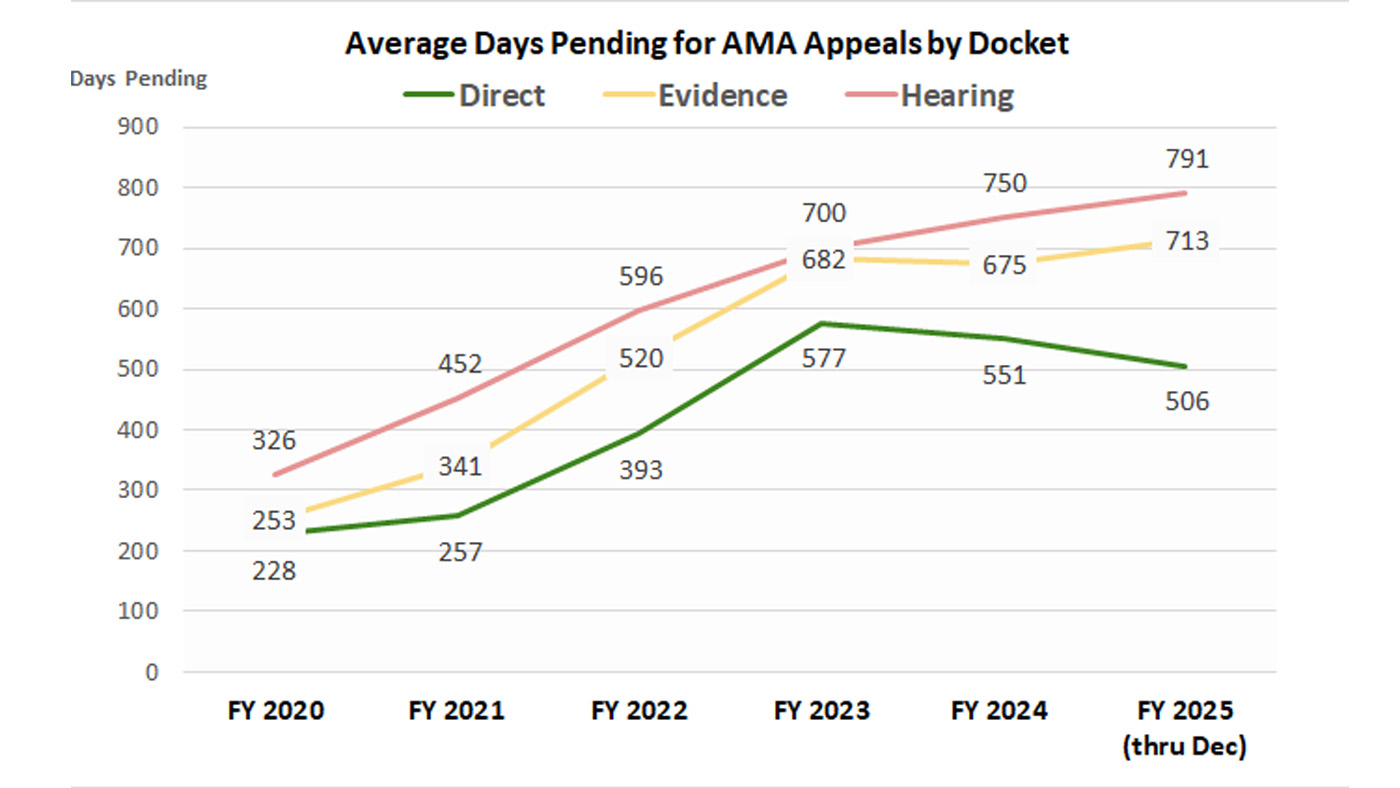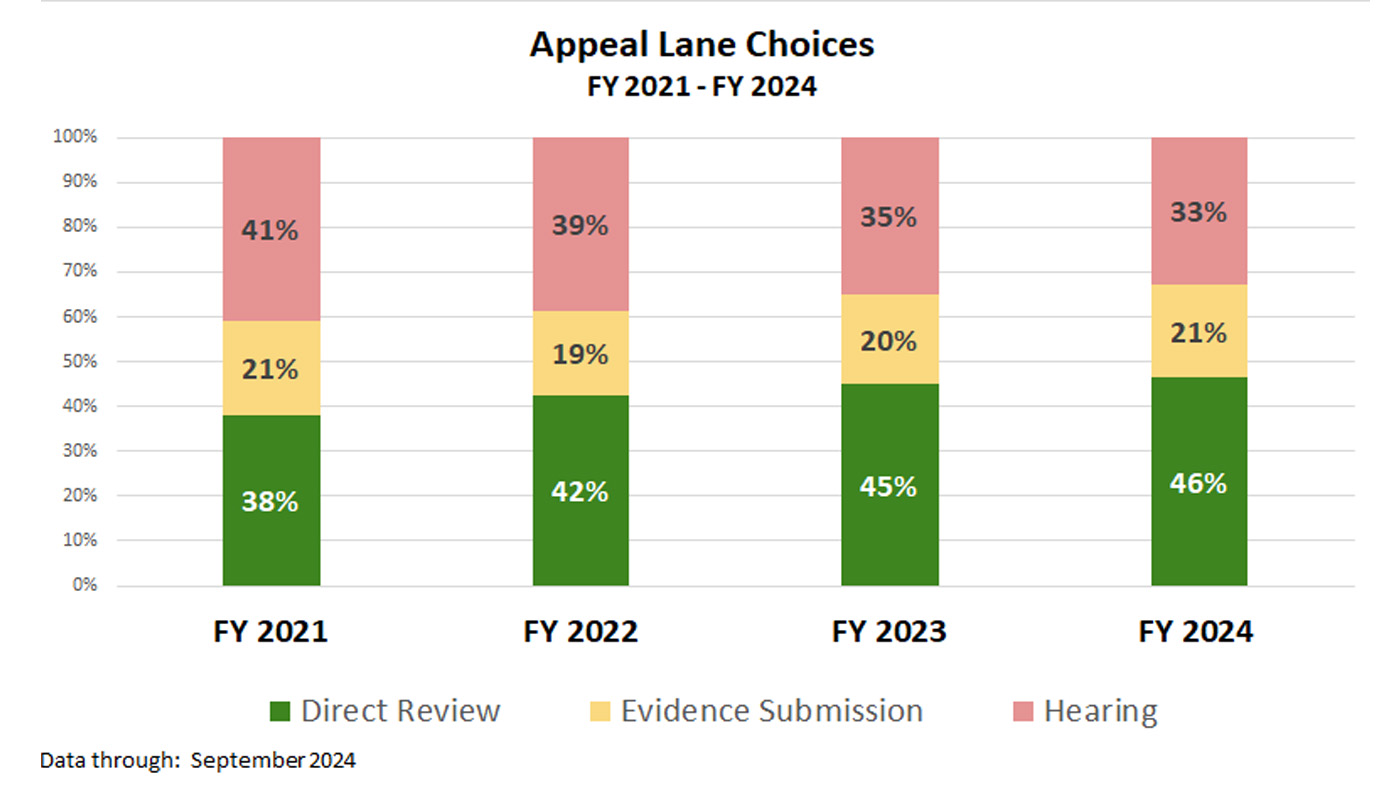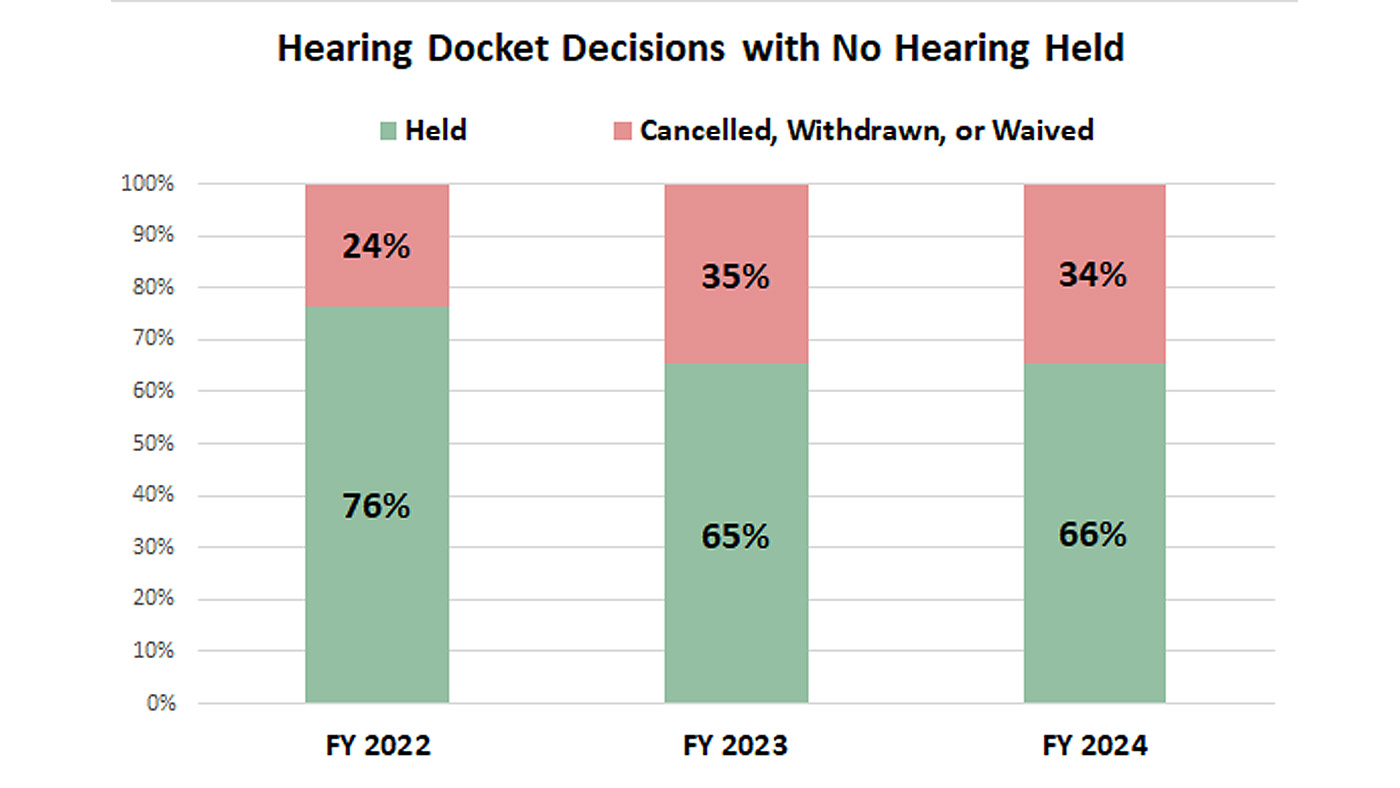Board of Veterans' Appeals
Veteran Choices for Type of Board Appeal Influences Wait Times
The AMA applies to all claims for which VA issues an initial decision on or after February 19, 2019. Previously, in the Legacy system, a Veteran or appellant could only appeal an unfavorable decision to the Board. Now, a Veteran can request review of an unfavorable decision through three different review options, or “lanes:” Higher-Level Review (HLR), Supplemental Claim, or appeal to the Board. Board review is only one of three options to request review, and it might not be the best option depending on a Veteran’s specific circumstances. Additional information about Higher-Level Review and Supplemental Claims can be found on the Appeals Modernization page. If a Veteran requests Higher-Level Review or files a Supplemental Claim, they can still appeal to the Board if they disagree with the new decision. As noted above, ever-increasing numbers of Veterans are choosing to "appeal first” to the Veterans Benefits Administration (VBA) before coming to the Board and many are getting the full relief they seek through that process rather than having to appeal to the Board, which is their only option under the Legacy appeals system.
As the AMA emphasized, Veteran choice is an important factor in how long it will take to resolve an appeal. For Veterans and appellants choosing to appeal a decision directly to the Board, there are now three different review options, or “dockets,” they can choose from that best meet their unique circumstances:
- Direct Review docket: The fastest way to receive a decision when a Veteran or appellant believes everything needed to approve their claim is already in the file. The Board will not consider any new evidence, and the VLJ will decide their case based on the evidence in the record at the time of the decision they are appealing.
- Evidence Submission docket: Some Veterans know they want or need to add additional evidence into their file before consideration by a VLJ. In that case, the Evidence Submission docket allows for additional evidence to be submitted by the Veteran or their representative within 90 days of appealing to the Board.
- Hearing docket: On average, it takes the longest to receive a Board decision for appeals on the Hearing docket. This option is best if a Veteran wants to appear personally before a VLJ. In most cases, this is done over video. However, this option will involve the longest wait time. View the Choosing a Decision Review Options page for more information on choices available to Veterans under the AMA. The Board’s projections for how quickly AMA cases will be decided stems directly from the choices that Veterans and their representatives determined were best for their individual circumstances.
View the Choosing a Decision Review Options page for more information on choices available to Veterans under the AMA.
The Board’s projections for how quickly AMA cases will be decided stems directly from the choices that Veterans and their representatives determined were best for their individual circumstances.
Below is a graphical trend of these ADP changes over the past 5 years after AMA was fully implemented and the Board workload transitioned from adjudicating mostly Legacy cases until the last half of FY 2024:

TITLE GOES HERE
As shown in the graph above, the ADP represents how long, on average, Veterans have been waiting in line for each AMA docket. The ADP will vary depending upon which docket (i.e. Direct Review, Evidence Submission, Hearing) the Veteran chooses. Some Veterans and appellants will get a decision faster than the average, and some will wait longer. There are a number of factors that impact how long it will take to get a decision. For example, now the Board is able to adjudicate a higher proportion and number of AMA appeals, the Board is rapidly deciding those AMA appeals that have been pending the longest in each docket, especially the Direct Docket. The Board has always publicly reported the average days to complete AMA appeals will exceed established timeliness goals before cresting and then settling back to within published goals. That is already happening with the Direct Docket, especially for those Veteran cases related to disability compensation and pension appeals, with the ADP now approximately 400 days.
These trends are encouraging signs that VA is achieving faster resolutions of AMA appeals when compared to the slow rates of resolution under the older Legacy system of appeals. The average time required to fully resolve AMA appeals, meaning all issues have received a decision on the merits by a VLJ, is currently more than 5 years faster than it takes to fully resolve Legacy system appeals. This positive trend will continue to get even better as the pace of AMA adjudication at the Board continues to accelerate.
As you can see above, cases where a Veteran or appellant requests a hearing take the longest time to receive a decision. If you request a hearing, it can take more than two years to hold a hearing and to get your decision. The reason it is taking the Board so long to resolve appeals in the hearing docket is based on two key factors: (1) The large number of Veterans choosing the hearing lane; and (2) The large number of “no shows” and scheduled hearings that are withdrawn too late to fill the slot with another waiting Veteran.

TITLE GOES HERE
It’s important to keep in mind there are only so many Veterans Law Judges at the Board and judges are the only ones who can both hold hearings and decide cases. The Board has the capacity to hold approximately 1,000 hearings each week, but most Veterans are represented for free by Veterans Service Organization partners who do not have that same capacity. Additionally, nearly one out of every two scheduled hearings are cancelled or withdrawn with insufficient time to fill that empty slot with another Veteran who is patiently waiting in line. Worse, the Board’s judges have spent precious time reviewing case files and preparing for hearings that were not held. This factor is important because Veterans in the AMA Hearings Docket ultimately choose not to attend their scheduled hearing about 35% of the time. Stated another way, approximately 35% of all Hearing Docket cases decided never had a hearing before a judge. As shown below, over a third of all scheduled Board hearings are cancelled, withdrawn, or waived altogether. This highlights the challenge to help ensure judge availability is maximized for all Veterans waiting in line for a hearing.

TITLE GOES HERE
The Board’s leadership monitors the Board’s finite resources to balance holding Veteran-requested hearings and issuing decisions for Veterans. Although the number of pending appeals with a hearing request is currently just under 70,000, the trends above show approximately 35% or more of those hearings will be cancelled, withdrawn, or waived, and this often happens after the Veteran has already waited in that hearing docket line for years. Therefore, a Veteran may be able to substantially reduce wait times by changing their AMA Hearing Docket appeal to either the Direct Docket or Evidence Submission Docket. This can be done any time prior to their requested hearing being scheduled/held.
Another point is worth mentioning for the convenience of Veterans. Virtual hearings with a judge do not require a Veteran to travel at all. While the overwhelming majority of hearings currently held by the Board are virtual tele-hearings where the Veteran can participate in the hearing from their home, the Board has noticed an increasing number of Veterans are now opting to travel to Regional Offices (ROs) to meet with Board judges via video using teleconferencing equipment at those VA facilities. During the pandemic, over 95% of Veterans chose virtual hearings with judges from their homes and other places of convenience. More recently, only about 75% of Veterans choose this virtual hearing option with a judge and it remains unclear why 25% prefer traveling to a RO for a video hearing with the same judge.
Below are some links that help explain why the appeal wait times grew and what the Board has been doing to improve.
- Workload Challenges of Two Separate Appeals Systems
- Requirements to Work Cases in Docket Priority Order
- More Board Personnel Address Pending AMA Appeals and Wait Times
- AMA Appeals System Shows Improvements Over Older Legacy System
- Veteran Choices for Type of Board Appeal Influences Wait Times
- Better Decision Quality Leading to Fewer Court Appeals
















